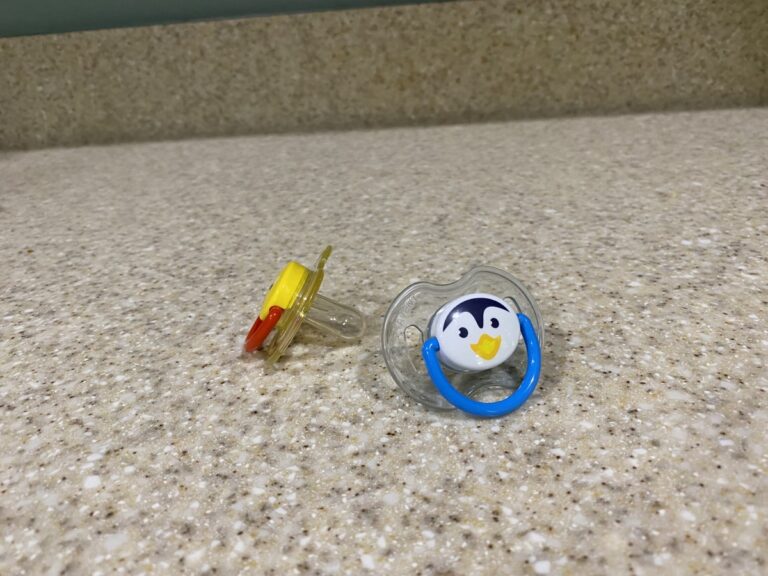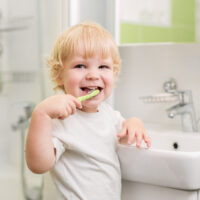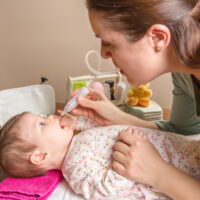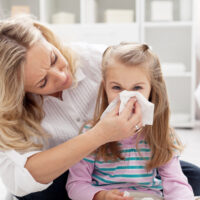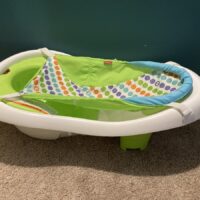Pacifiers come in all shapes, materials, and colors. While there isn’t a one-size-fits-all solution, we’ve compiled our list of the best pacifiers below. We chose pacifiers made from silicone (which is easier to keep clean and more durable than some other options) in a variety of shapes, so there are plenty of options for babies of all ages.
Best Pacifiers
NUK Comfy Orthodontic Pacifiers
The NUK Comfy Orthodontic Pacifiers are single-piece pacifiers made from medical-grade silicone. It’s recommended for ages 0-6 months.
These are designed especially for preventing irritation around your baby’s mouth. They have a heart-shaped shield that leaves a divot for your baby’s nose and a design that allows plenty of airflow, preventing moisture build-up and rashes. Additionally, the silicone is very soft against your baby’s skin.
Like NUK’s other pacifiers, the nipple is made using a soft silicone design that mimics the feeling of a woman’s breast. The shape is also modeled after the breast to help prevent nipple confusion. Additionally, it’s an orthodontic nipple that won’t affect the development of your baby’s jaw and teeth.
With the one-piece design, this is safer for your baby. This NUK pacifier also won’t trap water as easily as some other options, unless it is damaged. It is top-rack dishwasher safe.
While the silicone does prevent irritation, it also collects fuzz from blankets, dust, and pet hair. However, it’s easy enough to rinse clean when that happens. The other downside for some parents is the color. Once delivered, the color is much darker than it appears in the picture.
Pros
- Made using medical grade silicone
- One-piece design is safer
- Doesn’t trap water
- Soft against your baby’s skin
- Unlikely to cause nipple confusion
- Great for sensitive skin babies
- Allows lots of airflow
Cons
- Not the same color pictured
- Easily collects dust, fuzz, and hair
The First Years Gumdrop Newborn Pacifier
The First Years Gumdrop Newborn Pacifier is a single-piece silicone pacifier. It’s recommended for babies ages 0-3 months.
Something nice about this pacifier is the shape of the shield. Instead of being completely round, there is a curved area where your baby’s nose can sit more comfortably. This may give parents more peace of mind if their baby uses a pacifier at night since it won’t interrupt their breathing.
Another benefit is that the rounded nipple shape is unlikely to cause nipple confusion. Additionally, if your baby does like this pacifier, it is available in a larger size for babies older than three months.
The silicone material used to make this is free of BPA, latex, and phthalates. Something to note about the material is that it seems a little sticky. It easily collects things like dust or dog hair, so you’ll want to keep wipes handy to keep it clean.
On the back, this pacifier has a built-in tab to help you keep the pacifier in your baby’s mouth. There is a small hole in the tab, as well as holes for ventilation in the shield. Some mothers have said their baby’s fingertips occasionally get stuck in these holes.
Pros
- Single-piece design
- Design is available for older babies too
- Free of BPA, latex, and phthalates
- Curved area under your baby’s nose
- Unlikely to cause nipple confusion
- Ventilation holes in the shield
Cons
- Babies small fingers could get stuck in ventilation holes
- Picks up a lot of dust and hair
RaZbaby JollyPop Baby Pacifier
The RaZbaby JollyPop Baby Pacifier is recommended for babies aged 0-3 months. It is a popular choice in NICU units in hospitals across the United States and was invented by the creator of the Soothie pacifier.
The RaZbaby JollyPop pacifier has a soft nipple with a soothing design. It’s made from 100% lightweight silicone, which results in a design that isn’t too heavy to keep in your baby’s mouth. The silicone pacifier is also constructed in a single piece, so there’s no risk of choking.
Since this pacifier has an open design, it’s impossible for water to get trapped inside the nipple. You can also fit your finger inside when your baby is teething. The pacifier is also very easy to clean, especially with it being dishwasher safe.
This features a soft shield that won’t irritate your baby’s sensitive skin. It also has air holes to stop moisture from getting trapped and a carved-out area at the top where your baby’s nose sits. This ensures the pacifier doesn’t block their airway.
On the back of the pacifier, there is a tab that caregivers can hold onto. However, it may not be as easy for some babies to grab onto. Some babies also have trouble holding this in their mouths. This is likely because the shape of the nipple on this pacifier is a little shorter than some other options. However, some babies might prefer this design.
Pros
- One-piece design made of soft silicone
- Nipple has a rounded shape many babies prefer
- Made by the creator of the Soothie
- Cutout to keep babies nasal passages open
- Lightweight design
- Used in NICUs and hospitals across the US
- Water can’t get trapped inside
- Easy to clean
- Tab on the back for caregivers to hold onto
Cons
- Some babies have trouble with dropping the pacifier
- Nipple shape is shorter
Itzy Ritzy Sweetie Soother Pacifier
The Itzy Ritzy Sweetie Soother Pacifier is made of food-grade silicone free of BPA and PVC. It’s recommended for babies that are newborn age and older.
This features a single-piece design, so it’s less likely to be a choking hazard. Itzy Ritzy pacifiers come in a wide range of cute colors for boys and girls. They also have a cute, collapsible handle that features designs like arrows, bows, or a braid.
The entire pacifier is made from a thick silicone material that doesn’t break down easily, which is great for withstanding a baby that might be teething. However, the nipple is also soft enough that your baby can easily use it. Something to note, however, is that the material is also a little sticky so it can collect dust and hair easily.
Since this pacifier is rounded, it doesn’t affect the development of your baby’s teeth and jawline. This means you may be able to use it longer than other pacifiers you buy for your baby as a newborn.
While the thick design makes this more durable, the pacifier is also on the heavier side. If your baby stops sucking on it, it easily falls out of the mouth. This is especially true for younger babies. However, many mothers report that the unique design of the handle makes it easier for their baby to pick the pacifier up.
Pros
- Made of 100% food-grade silicone
- Lots of cute colors and designs available
- Single-piece design
- Silicone is thick and durable, but soft
- Unique handle is easier for some babies to grab
- Doesn’t affect tooth and jaw development
Cons
- On the heavier side
- Collects dirt and hair easily
Philips Avent Soothie Pacifier
The Philips Avent Soothie Pacifier features a safe, one-piece design. You may already be familiar with this if you’ve already had your baby — it’s the pacifier most hospitals give out in their goodie bag when your little one is born.
This pacifier is made from soft, medical-grade silicone. It is BPA-free, easy to handle, and even easier to clean. The pacifier can be cleaned in a sterilizer and is dishwasher safe.
Something nice about the design of the nipple is that it’s symmetrical. It can be turned any way to put in your baby’s mouth. Additionally, the nipple is hollow on the inside so you can put your finger in it when your baby is teething to provide some relief.
The shield around the base of this pacifier is vented, so it won’t stick to your baby’s face. There is also a small piece of silicone that you can easily hold onto. Another benefit is that the soft silicone prevents nipple confusion, especially in breastfed babies.
Something to keep in mind, however, is that this has a very basic shaped nipple. Not all babies will prefer this shape and some parents report that it falls more easily out of their little one’s mouths than some others on the market.
Pros
- Soft pacifier prevents nipple confusion
- Single-piece design
- Nipple is hollow inside
- Easy to handle
- Easy to clean, dishwasher safe
- Vented shield
- Symmetrical design
Cons
- Babies might not prefer this shape
- Can fall out easily
Nanobebe Baby Pacifiers
The Nanobebe Baby Pacifiers are made from BPA- and phthalate-free medical grade silicone. They are incredibly flexible, which lets them sit comfortably on your baby’s face.
The nipple and shield are made from very flexible and soft silicone. It curves ergonomically around your baby’s face, having a divot at the top and bottom that fits your baby’s nose and chin. The shield also has air holes to prevent skin irritation from trapped moisture.
These pacifiers have an orthodontic design that won’t interfere with oral development. Something to consider about the nipple is the length. For some parents, this might be a plus if their baby has struggled with choking on pacifiers with a longer design. If your baby has trouble keeping a pacifier in their mouth, however, the shorter design may be a disadvantage.
This pacifier features a one-piece design that is safer for your baby. The large, open back means you can put your finger inside for your baby to chew on and that it is impossible for water to get trapped inside.
One of the downsides of this pacifier is that there is no ring or button in the back. This can make it harder for your baby to pick up the pacifier and put it in their mouth. It also has a thicker design, so it’s harder than other pacifiers. This might be an advantage or disadvantage, depending on your baby’s preference.
Pros
- Ergonomic design fits comfortably on your baby’s face
- Airflow prevents skin irritation
- Thick, durable design
- Shorter nipple length is better for babies that choke on other pacifiers
- Made from flexible, medical-grade silicone
- One-piece design
- Doesn’t trap water
Cons
- Nipple is harder silicone than some other choices
- Can be harder for baby to pick up
- Shorter nipple length might not work for some babies
Best Pacifier for Preemies
Philips Wee Thumble Pacifier
The Philips Wee Thumbie Pacifier is specifically designed for babies born before the gestational age of 30 weeks. It’s especially helpful for babies that have been tube fed since pacifiers encourage the suckling reflex that babies develop between 30 and 35 weeks in the womb.
The nipple is also designed to mimic the small size and shape of a preemie’s thumb. It has a thin, long design with a rounded end.
This does have a smaller shield than some others, however, it is designed to work with CPAP, feeding, and ventilation tubes that preemies may need in the NICU. It is not so small that it could easily be swallowed, however, your baby should use the pacifier under supervision. You should note that this is not designed for older babies- it does pose a choking hazard when it is not used as recommended.
Before using this pacifier, the company recommends boiling it for five minutes which may cause discoloration. Additionally, it should be replaced every four weeks for hygiene reasons. Depending on how old your baby is, this might mean 3-4 replacements. Unfortunately, the pacifiers are also on the pricier side.
Pros
- Smaller size to accommodate NICU tubing
- Encourages development of the sucking reflex
- Helps babies with low birth weight
- Shaped like a baby thumb
- Unique design keeps pacifier centered
- Gives preemie babies comfort
Cons
- Expensive
- Needs to be boiled for five minutes before use
- Needs replaced every four weeks
Best Eco-Friendly Pacifier
Natural Rubber Pacifiers
The Natursutten Orthodontic Pacifier are a great option for parents who don’t want to use silicone or plastic because they are a man-made material. Rubber is all-natural and plant-based, making this the most eco-friendly pacifier for your baby. This is recommended for babies ages 6 – 12 months and older for its orthodontic shape; however, they do have pacifiers in other available sizes.
This pacifier features an orthodontic shape that is flat on the bottom and rounded on the top, mimicking the shape of your baby’s palate. This lets the pacifier sit in their mouth comfortably without interfering with oral development. The shield is also designed for comfort. It has cutouts for your baby’s nose and chin and has plenty of air holes.
The ring on the back of this pacifier makes it easier for your baby to hold. It also has a one-piece design that isn’t a choking hazard and does not have crevices for germs to hide in.
This pacifier was designed by a mother of 3 and even the ink and the packaging are safe for the environment. The company adheres to the strict European and US guidelines.
Pros
- All-natural, plant-based
- Eco-friendly pacifier and packaging
- Available in four types and sizes, up to 36 months
- Orthodontic shape for proper mouth and jaw development
- Air holes in the shield
- The shield is designed to fit your baby’s face
- One-piece design
Cons
- Not every baby loves the shape
Best Pacifier for Breastfed Babies
NUK Orthodontic Pacifiers
The NUK Orthodontic Pacifiers are a good choice for breastfed babies since the nipple is modeled after a breast nipple, which reduces the chance of nipple confusion. This is recommended for babies ages 6-18 months, however, you can find NUK Orthodontic Pacifiers for ages 0-6 months. These are also available for babies aged 18-36 months.
These pacifiers are made from BPA-free silicone and plastic. The nipple has an orthodontic design, being flatter and thinner so it doesn’t get in the way of your baby’s dental development. They also have air holes in the shield.
Another benefit is that these glow in the dark. This makes it easy for you or your baby to locate them if the pacifier dropped at night.
These baby pacifiers also come in a storage case that doubles as a microwavable sterilizer. They can be cleaned in the top rack of the dishwasher, too.
Unlike some of the other options, this isn’t a single-piece pacifier so they pose a greater choking risk. Water also gets inside the nipple sometimes, especially if you boil it a lot. Even baby drool might get inside. It does dry out most of the time, but you’ll want to watch it closely for bacterial growth. The moisture also causes the pacifier to make a squeaking sound sometimes.
Pros
- Reduces nipple confusion
- Orthodontic nipple doesn’t interfere with tooth and jaw development
- Heart-shaped shield to keep your baby’s nasal passages open
- Storage case works as microwave sterilizer
- Top-rack dishwasher safe
- Glows in the dark
Cons
- Doesn’t always dry out completely
- Sometimes makes a squeaking sound
- Not a single-piece pacifier
RELATED: Best Pacifiers for Breastfed Babies
Best Pacifier for Sensitive Skin
MAM Air Pacifiers
The MAM Air Pacifiers feature a design made specifically for babies with sensitive skin. They are recommended for ages 6 months and older.
These pacifiers have an orthodontic-shaped nipple that won’t harm your baby’s developing teeth and jawline. They also have a textured nipple, which helps keep it in your baby’s mouth. Another plus is that the design can be placed anyway since it is the same on all sides.
Like all MAM pacifiers, this uses SkinSoft silicone. The soft silicone is thin and flexible. While this is great for getting your baby to take the pacifier, it also means that these can be damaged over time. This is especially true for babies who have teeth coming in. You’ll want to inspect for damage regularly and replace these as needed. Even if there are only small holes, water might get trapped inside the pacifier and promote bacterial growth.
With the wider, open shield design, the MAM air pacifier prevents skin irritation around the mouth in babies with sensitive skin or conditions like eczema. However, some babies have a little more trouble holding this than other pacifiers.
Something else nice about this is that it comes with a sterilizing case. You can place the pacifiers inside the case and put them in the microwave for sterilization. This also doesn’t break the silicone down as much as boiling them.
Pros
- Great for babies with especially sensitive skin
- Unique, open design prevents irritation
- Textured nipple is easier for baby to grip
- Made of soft, flexible silicone
- Orthodontic nipple
- Comes with a sterilization case
Cons
- More than one piece
- Some babies struggle holding it
- Nipple is easy to chew through
Best Glow-in-the-Dark Pacifier
MAM Day and Night Pacifier
The MAM Day and Night Pacifier come with 2 daytime pacifiers and a nighttime pacifier that glows in the dark. The pacifiers feature a cute design with cute animal characters and stars, perfect for boys and girls. They are recommended for ages 6-18 months.
These MAM pacifiers have a silicone nipple and a base made from BPA- and BPS-free plastic. The nipple features a symmetrical design, so there’s no wrong way to put it in your baby’s mouth. It is made from very soft silicone. While this is nice because it’s comfortable for your baby to suck on, it also may break down over time. This is especially true if your baby chews on their pacifier or has erupting teeth.
One of the pacifiers in this set glows in the dark, which is perfect when your baby loses it in their crib during the night. It charges naturally with exposure to natural light and has a faint glow that won’t disrupt your little one’s sleep.
Around the base, the wideset design makes this pacifier impossible for your baby to swallow. It is also very well ventilated, so it won’t stick to your baby’s face or cause irritation.
One downside of this style of a pacifier is that it has more than one piece. This means you’ll have to watch it closely while your baby is using it and inspect it regularly for signs of damage.
Pros
- Faint glow that won’t disrupt your baby’s sleep
- A glow-in-the-dark pacifier is easy to find at night
- Wide, ventilated shield
- Super soft nipple is comfortable
- Made of silicone and BPA/BPS-free plastic
- Cute, unisex design
- A symmetrical nipple means there isn’t a right side to the pacifier
Cons
- Pacifier has more than one piece
- Nipple doesn’t withstand chewing well
How We Selected Pacifiers
Age and Stage
As you look for the best pacifier for your baby, consider how old they are. Pacifiers come in stages that coincide with their age and the development of their mouth. Additionally, pacifiers designed for bigger babies are going to be larger so they don’t pose a choking risk if your child pulls the paci into their mouth. You should follow manufacturer recommendations on age and speak to your pediatrician if you’re unsure.
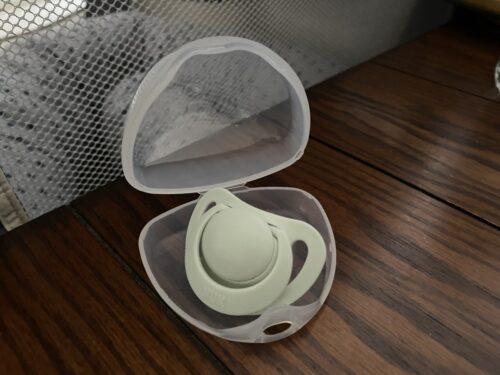
Shape
The most common shapes for pacifiers are a variation of rounded or orthodontic. Rounded pacifiers are better for younger baby’s since they better mimic the feeling of a nipple. Once your baby is older, an orthodontic pacifier is going to promote the proper development of their jaw and facial muscles. These usually have a beveled top.
There are also other shapes and textures. Some pacifiers may have an oval design. Others are designed with a wide top or bumps, which might be beneficial when your baby is teething. Even though your baby might have a favorite style of a pacifier, having a few different shapes for your baby’s needs may be helpful.
Shield
The shield is the area around the base of the pacifier. It stops the pacifier from being sucked into your baby’s mouth, significantly reducing the risk of choking. As a general guideline, the shield should be at least 1.5″ across. Additionally, be aware of contoured shield shapes that don’t have air holes or ventilation. If the pacifier sticks to your baby’s face, moisture builds up underneath and causes skin irritation.
Number of Pieces
Some pacifiers have more than one piece, which might make the pacifier easy to clean. However, pacifiers with more than one piece must be watched more closely. Even if the pacifier is designed well, small parts and attachments wear down with time. This is especially true if you are regularly cleaning/sanitizing your baby’s pacifier.
Cleanliness
Baby pacifiers get dropped- in the car, at the grocery store, and on the floor at nap time. With something that is regularly getting covered in germs, you want to be sure the pacifier is easy to clean. While most can be wiped clean, some are even dishwasher safe. You’ll also want to be aware of any small pockets or areas that would trap drool and debris or be difficult to clean.
Materials Used
Some of the most common materials used for pacifier nipples include silicone, rubber, and latex. The body of the pacifier may also use silicone, rubber, latex, or plastic. Some parents worry about chemicals leaching from plastic — especially if you boil your pacifiers to sterilize them. Look for manufacturers that use BPA-free plastic or look for a design that avoids plastic use altogether.
Silicone is the most common material used (and our most recommended). Latex pacifiers are more porous than silicone, so they collect bacteria easier. There is also a risk of a latex allergy. With rubber, the material breaks down easier over time. Silicone is also preferred because it withstands high temperatures (which is great for easily sterilizing your baby’s pacifiers).
Special Circumstances
For some babies, you may need to choose their pacifier based on certain qualifications. For this reason, we tried to include a variety of pacifiers. Some are best suited to babies born early or in the NICU, while others feature an all-natural design that doesn’t use man-made materials.
FAQs – Pacifiers
What are the pros and cons of pacifiers?
Benefits of Pacifiers
Giving your baby a pacifier has a host of benefits. When given to your baby at night, their pacifier keeps them from sleeping too deeply and reduces the risk of SIDS significantly. Your child’s pacifier is also an invaluable source of comfort that helps them self-soothe, whether it is nighttime or during the day when they are feeling fussy.
If your baby is experiencing discomfort, pacifiers are a great distraction. They work well during doctor’s visits when they are being left with a sitter, and other times when your baby is feeling uncomfortable. For parents planning on traveling, pacifiers also help with popping ears on an airplane.
Pacifiers are also a great alternative to sucking on the fingers/thumb. Since you cannot take away your baby’s digits like you can a pacifier, it gives you more control when weaning.
Drawbacks of Pacifiers
There are also a few things to keep in mind about using pacifiers. If you constantly use the pacifier to soothe your little one, there’s a risk that they will become too attached to it. Additionally, you should rule out other sources of fussiness (like sleepiness, hunger, a wet diaper, etc.) before giving a pacifier.
Most of the risks associated with pacifier use happen after your baby is six months. (For this reason, the guidelines from the American Academy of Pediatrics and American Family Physician recommend weaning your baby from their pacifier at six months). These include a greater risk of ear infections (though this doesn’t apply to all babies) beginning at six months and a greater risk of teeth misalignment when used after age two years.
How do I get my baby to take a pacifier?
You should never force your baby to take a pacifier. However, there are several tricks you can use to tempt him or her. One method you could use if offering it right after your baby finishes feeding. Since they are still suckling, they may be more willing to take the pacifier. You could also put a drop of breast milk or formula on the tips of the pacifier and tickle their lips with it. While you shouldn’t force it in, it is okay to get them familiar with it. You could even let your baby play with it.
Something else to keep in mind is that some babies have a startle reflex when they are younger. They may push things out of their mouth (this is a natural reflex that prevents them from choking). If your baby likes the pacifier but spits it out, you can hold it in place in their mouth if they allow it. You can learn more about how to get a baby to take a pacifier here.
Keep in mind that you will likely want to wait until your baby has a well-established eating routine before introducing a pacifier to prevent confusion. This usually happens around 3-4 weeks of age.
How many pacifiers do I need?
Once your baby develops a favorite style of a pacifier, you’ll want to keep 3-4 pacifiers on hand. Pacifiers are small and easy to lose track of in the car, at the store, on the sidewalk, in the bottom of the diaper bag- anywhere. Even if you do happen to notice the pacifier fall, you’ll still need to sterilize it before handing it back to your baby. Having a few extras ensures you’re always ready.
Final Word
It’s hard to really name any pacifier as best since all babies are unique in their preferences. For us, however, the top choice was the Nanobebe Baby Pacifier. We liked the soft shield and how it stays in baby’s mouth easier than some other baby pacifiers. Additionally, it doesn’t trap water, it fits under your baby’s nose, and there are air holes to prevent skin irritation.
Keep in mind that the biggest factor in choosing the best pacifiers is your baby’s preference. Don’t be afraid to try a few styles until you get it right- but pay attention to the stage so the pacifier doesn’t interfere with your baby’s mouth development.
